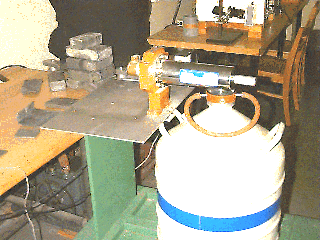|


Production and absorption of
X-rays; Moseley's law; fine structure of the K
lines of the elements. A cooled intrinsic germanium
solid-state X-ray detector is used to measure
the spectra of X-rays under a variety of circumstances
that illustrate several of the important phenomena
of X-ray physics. Phenomena observed and measured
include the production of X-rays by fluorescent
excitation, bremsstrahlung, and electron-positron
annihilation and the absorption of X-rays by photoelectric
interactions, Compton scattering, and pair production.
The energies of the K X-ray
lines of numerous elements are measured and compared
with the predictions of Moseley's Law. The energy
separations and relative intensities of the Ka
and Kb lines are measured and compared with the
theory of fine structure in the n=2 orbitals.
Download
Lab Guide in PDF format
Download
Lawrence Berkeley Lab X-ray Data Booklet in PDF format
(certificates
required)
 - [1901] Wilhelm Conrad Rontgen's Nobel Lecture (1901) <<recognition of the extraordinary services he has rendered in the discovery of the remarkable rays subsequently named after him>>
- [1913] H.G.J. Moseley,"The
High-Frequency Spectra of the Elements, Part
I", Phil Magazine, No. 26, Page 1024
- [1913] H.G.J. Moseley,"The
High-Frequency Spectra of the Elements, Part
II", Phil Magazine, No. 26, Page 1024
- [1923] A.H. Compton,"The Spectrum of Scattered X-Rays", The Physical Review, Second Series, Vol. 22, No.5, November
- [1924] Karl
Manne Georg Siegbahn's Nobel Lecture (1924)
<<for his discoveries and research in
the field of X-ray spectroscopy>>
- [1927] Arthur Holly Compton's Nobel Lecture (1927) <<for his discovery of the effect named after him>>
- [1935] A.H. Compton and S.K. Allison, The
Interpretation of X-ray Spectra, pp.590-595
in X-Rays in Theory and Experiment, D. Van Nostrand,
2nd Edition
- [1935] A.H. Compton and S.K. Allison, The
Interpretation of X-ray Spectra, pp.647-655
in X-Rays in Theory and Experiment, D. Van Nostrand,
2nd Edition
- [1967] J.a. Bearden, X-Ray Wavelengths, Rev. Mod. Phys. Vol. 39, No. 1, January
- [1978] K. Way,"Atomic Data Related to X and XUV Radiation" from Atomic Data and Nuclear Data Tables Vol. 22, pp.125-130
- [1979] M.O. Krause and J.H. Oliver, Natural Linewidths of Atomic K and L Levels, K-alpha X-Ray Lines, J. Phys. Chem. Ref. Data. Vol. 8, No. 2, pp. 329-338

- NIST X-Ray Transition Database
- Diagram showing older notation for x-ray transitions (From Compton and Allison (1935)
- Description of Amersham AMC2084 Variable X-Ray Source
- IUPAC
- X-Ray Generation Notes (Sec: 10.2.1.2)
- IUPAC
- X-Ray Spectroscopy Terms (Sec: 10.3.4.8)
|